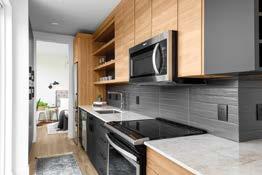
6 minute read
Greenstreaming” of Factory-Built Housing
Gordon Rattray
Manufactured and modular homes— under the umbrella term “factory-built housing”— are vastly different from the original mobile homes or trailers built in an era when those units came with wheels and axles.
Those homes were expected to have short-spans and to move frequently. Today’s homes • do not include wheels, • will probably not be moved following the original set-up, and • comply with modern codes and standards incorporating the latest construction practices and materials.
This article is intended to explain how factory-built homes are becoming more energy efficient and reduce environmental impacts, achieved through the industry’s own motivation, working in concert with the direction set by our respective governments. “Greenstreaming” is a term reflecting where our home construction practices are headed.
Governments across Canada, at both the federal and provincial levels, have been on a track toward the continual improvement in energy efficiency. That is in keeping with the federal government’s “Pan-Canadian Framework on Clean Growth and Climate.” A key goal of the strategy is to mandate Net-Zero Energy buildings. Net Zero is defined as buildings that produce as much clean energy as they consume.
In Canada, the National Research Council is responsible for developing the National Model Building Code. The NMBC is intended to guide the formulation of provincial building codes; respective provinces are able to adopt it, in whole or in part. A key component of the National Model Building Code is Part 9.36 that lays out requirements for improving energy efficiency.
In British Columbia, the Building Code is updated on a 6-to-7-year basis; the most recent update came into effect in 2018, with the previous update in 2012.
Commencing with the 2012 update, BC began moving toward adoption of Part 9.36. From 2012 to 2018, BC established transitional
Modern energy-efficient CSA A277 home constructed by Chaparral Built of Kelowna and winner of a 2019 MHABC Innovations Award. Interior of Chaparral Built A277 home displaying the use of modern, energy-efficient appliances.

provisions that brought into force the majority but not all elements of the NMBC 9.36.
With the 2018 update, the province moved to full implementation of Part 9.36. In concert with that, BC developed a strategy to establish energy-efficiency targets with a goal of achieving Net-Zero Ready New Construction by 2032. The strategy was implemented in 2017 and termed BC’s Energy Step Code. The Step Code became enforceable commencing December 15, 2017.
The Step Code is a new provincial standard that provides an incremental and consistent approach to achieve energy-efficient construction. The Step Code requires buildings to demonstrate energy efficiency code compliance through building energy modelling.
In summary, the Step Code provides five steps providing direction on the requirements to meet the individual steps. Individual communities can implement their own timelines for adoption of the individual steps and many are already moving to require the upper stages of the Step Code. Interested readers may access more information by Googling the BC Energy Step Code. How do the recent advancements influence energy efficiency for factorybuilt homes and how do they benefit the purchaser? The factory-built housing industry utilizes two key construction standards for full-time-occupancy homes that are the responsibility of our Canadian Standards Association. 1. CSA Z240MH (Manufactured Home) are homes built on steel frames.
The initial standard was created circa 1972 and were termed mobile homes or trailers because they included wheels and axles.
The Z240MH standard is a standalone building code that guides construction practices from frame-welding standards to required construction materials to ventilation requirements. This standard was last republished in 2016 in keeping with the continual improvement requirements of
CSA. While the updated standard materially complies with the 2018
BC Building Code requirements, there are some minor allowances on window, door, and skylight standards toward ensuring greater affordability of manufactured homes. 2. CSA A277 (Modular Home) is a plant standard requiring that all homes built in the respective plant are constructed in compliance with the BC building code in place when construction of the home commences. While A277 homes are generally constructed with the expectation they will be placed on perimeter cement foundations similiar to standard site-built homes, they can also be constructed on steel frames similar to the requirements set out in the Z240MH standard. Also, similiar to Z240MH, A277 was last republished in 2016.
Who Will See Your Ad in The Scrivener?
BC Notaries Lawyers Land Surveyors of BC Real Estate Professionals Real Estate Boards and Associations Age-Friendly Designates MLAs and MPs in BC Life Insurance Brokers and Agents Accountants Managers of Financial Institutions Investment Management Agencies Provincial and Federal Court Judges Registrars Mayors Government Ministries Libraries: Public and Private, including Law Society, Legal Services, Education Facilities Chambers of Commerce BC Housing BC Assessment BC Buildings Corporation
Fall Advertising Space Deadline September 15
scrivener@society.notaries.bc.ca www.notaries.bc.ca
The factory-built housing industry fully supports the government’s objectives to improve energy efficiency for BC homes. The industry has engaged energy-efficiency modelling resources and is undertaking the testing of homes being constructed. A key test is known as the blower door test, intended to assess the air-tightness of the homes. Preliminary results indicate factory-built homes are already meeting upper stages of the Step Code. Our homes will not have major challenges in meeting the Step Code demands and local government Step Code-implementation timing directives.
For the purchaser, manufactured and modular homes have smaller “footprints” with the majority of homes in the 1500 to 2000 square-foot range, less than typical site-built homes. The smaller size automatically results in lower energy demands especially related to heating requirements and associated costs.
In the construction of manufactured and modular homes, owing to the efficiencies of the plant That is due to centralized plants and delivering the materials to the respective plants. Further, moving the home to the final location provides for more energy-efficient transport . . . rather than having multiple vehicles deliver numerous loads of materials onto a construction site.

Lower energy demands result in less carbon formation, a major environmental issue. Compared to site-built homes, factorybuilt housing uses construction materials more efficiently. Less wastage results in less carbon-creation using materials such as Gyproc, cement products, and shingles and other petroleumbased products. Reductions in onsite construction time are also a major benefit. Many communities are becoming proponents of factory-built housing because the actual onsite construction time is so much less, resulting in less inconvenience for adjacent homeowners in more dense communities.
Further, the avoidance of construction personnel having to travel to the site on a daily basis for multiple months substantially decreases energy demands and carbon creation associated with personal vehicle usage.
The factory-built housing industry is committed to energy efficiency. That is reflected in the continual improvement of construction standards and the adoption of evolving technologies. The industry will continue to increase our market share of homes to BC purchasers because of construction convenience, greater energy efficiency, lower carbon creation, and optimal use of construction materials. s Gord Rattray is Executive Director of the Manufactured Housing Association of British Columbia.
Helping affluent families protect and grow their financial wealth.

DIXONMITCHELL.COM









